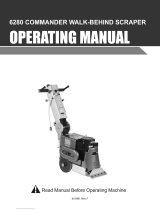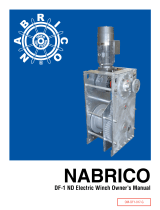Page is loading ...

Read Manual Before Operating or
Servicing Machine
402294 Rev C
71 POWERED CARPET PULLER
OPERATING &
SERVICE MANUAL


Features and Specications ......................................................................................................................................... 4
Safety .............................................................................................................................................................................. 5
General Rules for Safe Operation ......................................................................................................................... 5
Carpet Puller Safety Guidelines ............................................................................................................................. 6
Components and Assembly ......................................................................................................................................... 7
Transport ................................................................................................................................................................ 7
Set up .................................................................................................................................................................... 7
Pre-Operation Inspection ....................................................................................................................................... 8
Operation ........................................................................................................................................................................ 9
General operation .................................................................................................................................................. 9
Operating Controls ............................................................................................................................................... 10
Troubleshooting Guide ................................................................................................................................................11
Maintenance ................................................................................................................................................................. 12
Preventive Maintenance ...................................................................................................................................... 12
Cleaning ............................................................................................................................................................... 12
Rope .................................................................................................................................................................... 12
Pull Bar ................................................................................................................................................................ 12
Gripper Strips ....................................................................................................................................................... 12
Replacing Gripper Strips ...................................................................................................................................... 13
Lubrication ........................................................................................................................................................... 13
Adding/Changing Oil ............................................................................................................................................ 13
Changing the Output Oil Seal .............................................................................................................................. 13
Parts List and Diagrams ............................................................................................................................................. 15
Table of Contents
3402294_71_REVC

4
Features and Specications
FEATURES
High-Polymer Low-Stretch Cord - Non-nylon low stretch high poly-
mer cord designed for safer wench application (no cable).
Quick Shaft Disengagement - Waiting for the winch is not necessary
and allows for fast re-hooks.
One Person Operation - Cuts normal labor to a fraction, easy to use
on any job size.
Pull Bar - Strongest pull bars in the industry.
Sharktooth Base Gripper Teeth - Have a super hold even on at
carpet.
High-Polymer Low-Stretch Cord
Quick Shaft Disengagement
Pull Bar
Sharktooth Base Gripper Teeth
One Person Operation
Product Specications
Width Length Height Weight Speed RPM Input Power HP Amps (Full
Load)
29.5”
(75 cm)
34”
(86 cm)
42” (107 cm) w/
screen
10” (25 cm) w/
screen folded down
185 lbs. 15-22 ft/min. 1,725 110 1 12
402294_71_REVC

Safety
ENVIRONMENT
Avoid use in dangerous environments.
Do not use in rain, damp or wet locations, or in the presence of
explosive atmospheres (gaseous fumes, dust, or ammable mate-
rials). Remove materials or debris that may be ignited by sparks.
Keep work area tidy and well-lit - a cluttered or dark work area may
lead to accidents. Extreme heat or cold may affect performance.
Protect others in the work area and be aware of surroundings.
Provide barriers or shields as needed to protect others from debris
and machine operation. Children and other bystanders should be
kept at a safe distance from the work area to avoid distracting the
operator and/or coming into contact with the machine. Operator
should be aware of who is around them and their proximity. Sup-
port personnel should never stand next to, in front of, or behind
the machine while the machine is running. Operator should look
behind them before backing up.
Guard against electric shock.
Ensure that machine is connected to a properly grounded outlet.
Prevent bodily contact with grounded surfaces, e.g. pipes, radia-
tors, ranges, and refrigerators. When scoring or making cuts,
always check the work area for hidden wires or pipes.
5
GENERAL RULES FOR SAFE OPERATION
Before use, anyone operating or performing maintenance on this equipment must read and understand this manual, as well as any labels pack-
aged with or attached to the machine and its components. Read the manual carefully to learn equipment applications and limitations, as well
as potential hazards associated with this type of equipment. Keep manual near machine at all times. If your manual is lost or damaged, contact
National Flooring Equipment (NFE) for a replacement.
PERSONAL
Dress properly and use safety gear.
Do not wear loose clothing; it may be caught in moving parts.
Anyone in the work area must wear safety goggles or glasses,
hearing protection during extended use, and a dust mask for dusty
operations. Hard hats, face shields, safety shoes, etc. should be
worn when specied or necessary.
Maintain control; stay alert.
Keep proper footing and balance, and maintain a rm grip.
Observe surroundings at all times and use common sense. Do not
use when tired, distracted, or under the inuence of drugs, alcohol,
or any medication that may cause decreased control.
Keep hands away from all moving parts and tooling.
Wear gloves when changing tooling. Remove tooling when ma-
chine is not in use and/or lower cutting head to the oor.
Do not force equipment.
Equipment will perform best at the rate for which it was designed.
Excessive force only causes operator fatigue, increased wear, and
reduced control.
EQUIPMENT
Use proper parts and accessories.
Only use NFE-approved or recommended parts and accessories.
Using any that are not recommended may be hazardous.
Ensure accessories are properly installed and maintained.
Do not permanently remove a guard or other safety device when
installing an accessory or attachment.
Inspect for damaged parts.
Check for misalignment, binding of moving parts, loose fasteners,
improper mounting, broken parts, and any other conditions that
may affect operation. If abnormal noise or vibration occurs, turn
the machine off immediately. Do not use damaged equipment until
repaired. Do not use if power switch does not turn machine on and
off. For all repairs, insist on only identical NFE replacement parts.
Maintain equipment and labels.
Keep handles dry, clean, and free from oil and grease. Keep cut-
ting edges sharp and clean. Follow instructions for lubricating and
changing accessories. Motor and switches should be completely
enclosed at all times with no exposed wiring. Inspect cord regu-
larly. Labels carry important information; if unreadable or missing,
contact NFE for a free replacement.
Avoid accidental starting; store idle equipment.
When not in use, ensure that the machine is unplugged; do not
turn on before plugging in. Store in a dry, secured place. Remove
tooling when storing, and keep away from children.
MAINTENANCE & REPAIRS
Begin maintenance work only when the machine is shut
down, unplugged, and cooled down.
Use proper cleaning agents.
Ensure that all cleaning rags are ber-free; do not use any aggres-
sive cleaning products.
Schedule regular maintenance check-ups.
Ensure machine is properly cleaned and serviced. Remove all
traces of oil, combustible fuel, or cleaning uids from the machine
and its connections and ttings. Retighten all loose ttings found
during maintenance and repair work. Loose or damaged parts
should be replaced immediately; use only NFE parts.
Do not weld or ame-cut on the machine during repairs, or
make changes to machine without authorization from NFE.
CAUTION! ENSURE PROPER USE OF EXTENSION CORDS. IF AMP DRAW IS HIGHER THAN SHOWN ON
TABLE OR CORD IS LONGER THAN 50 FT, SEE AN ELECTRICIAN.
ASSUMPTIONS: 3% ALLOWABLE VOLTAGE DROP, COPPER CONDUCTORS RATED FOR 75OC, 1.25
SAFETY FACTOR, CORD VOLTAGE RATING OF 600VAC, PROPER CORD TYPES (STO, STOW, SOOW).
Amp Draw Gauge
0-12 14
13-16 12
14-24 10
25-40 8
One Person Operation
402294_71_REVC

Safety
6
CARPET PULLER SAFETY GUIDELINES
• Never stand in line of pull in case the rope breaks or the pull bar lets loose.
• Always have remote switches in hand.
• Do not allow yourself or others to become entangled in pulley, rope, winding shaft, or pull bar.
• Do not use any other type of rope that does not meet NFE specications (less than 6-8% stretch, 13900 pound tensile strength).
• Rope should always pull straight into the machine, never at an angle.
• Never have machine at an angle where the rope winds sideways on the shaft. This could cause the rope to wind improperly on the shaft
and damage the rope.
• Ensure hook is securely tied to rope.
• Know the working load limit (WLL) of the rope being used and ensure it is appropriate for the application.
• Do not bend rope around unprotected, sharp corners. Do not use over rough surfaces without chafe protection.
• Motor should not be run without a fan cover in place.
WARNING: DO NOT USE CABLE. DOING SO COULD CAUSE PROPERTY DAMAGE OR BODILY INJURY.
WARNING: THE IMPROPER USE OF ROPE IS DANGEROUS, AND COULD RESULT IN BODILY INJURY OR DEATH. ROPE WILL FAIL IF
WORN, DAMAGED, ABUSED, OVERLOADED, OR NOT PROPERLY MAINTAINED.
WARNING: DO NOT STAND WITHIN RECOIL (SNAPBACK) AREA, UNLESS PROTECTED BY SCREEN. FAILURE TO DO SO COULD
CAUSE SERIOUS BODILY INJURY OR DEATH.
WARNING: DO NOT USE ANY OTHER TYPE OF ROPE THAT DOES NOT MEET NATIONALS SPECIFICATIONS. OTHER TYPES OF ROPE
WHICH MAY HAVE THE PROPER WLL, GENERALLY HAVE A HIGH ELONGATION OR STRETCH FACTOR, MAKING MACHINE POTENTIALLY
DANGEROUS FROM ROPE SNAP BACK RESULTING IN BODILY INJURY OR DEATH. ONLY USE NATIONAL #71-P33 REPLACEMENT ROPE
FOR SAFE OPERATION. FAILURE TO DO SO COULD CAUSE PROPERTY DAMAGE OR BODILY INJURY. NEVER USE CABLE.
402294_71_REVC

7
Components and Assembly
FIG. 1
TRANSPORT
• Cover gripper strips during transportation or when machine is not in use.
• Use caution near gripper pins to avoid getting scratched. They are sharp.
• Fold screen down and secure with screen pins (Figure 1).
• When machine is not in use, lay machine down at to safely store (Figure 2) and
keep pin guard cover in place.
• When machine is being transported, lay machine at (Figure 2). Secure machine to
wall of truck and keep pin guard cover in place.
• To move machine on jobsite, lean machine back onto wheels to roll like a two wheel
dolly, holding the screen as a handle (Figure 3). Remember to release any pres-
sure from rope before trying to move or reposition machine.
SET UP
1. Remove all debris from carpet area that machine will be anchored to. Keep pin
base clear of obstructions (sweep with broom, or vacuum).
2. Set machine down onto gripper strip.
3. Remove (2) screen pins connected to frame and screen (Figure 4).
4. Fold screen up and re-place screen pins on both sides of lower screen (Figure 5).
FIG. 2
FIG. 3
FIG. 4
7
FIG. 5
WARNING: DO NOT LEAVE MACHINE STANDING-UP FREELY (FIGURE 1).
WARNING: FAILURE TO FOLLOW ANY OF THE ABOVE INSTRUCTIONS
COULD CAUSE DAMAGE TO MACHINE, PROPERTY, OR SERIOUS BODILY
INJURY.
WARNING: NEVER USE MACHINE WITH DAMAGED GRIPPER STRIPS,
ROPE, PULLEY, PULL BAR OR SWITCH. FAILURE TO DO SO COULD CAUSE
PROPERTY DAMAGE OR BODILY INJURY.
Screen Pin
402294_71_REVC

8
Components and Assembly
8
PRE-OPERATION INSPECTION
• Make certain protective screens are in place before operating (Figure 6).
• Ensure rope guard is in place. Guard should be in the down position to cover rope
and drive shaft (Figure 7).
• Inspect weld points on pull bar for security.
• Inspect clamps to ensure they are not bent or damaged.
• Inspect for loose or damaged parts on the pulley wheel, pulley housing, pulley hook
and pin.
• Inspect rope for cuts or fraying. Replace frayed or damaged rope with NFE stock
#71-P33. Ensure hook is fastened correctly to rope. Do not tie knots in rope.
• Keep gripper strip pins clean and free from debris. Replace damaged pins with new
gripper strips, NFE stock #71-P7. Clean dirty pin strips with a stiff wire brush. Brush
in direction of pin angle.
• Inspect wiring for cuts or damage and switches to ensure they are in good working
condition. Switches must return to the off position when released.
• Ensure ll plug is installed on gear unit.
• Pulley should be inspected before each use. Loose or damaged parts should be
replaced immediately.
• Inspect area to be removed for any possible obstruction on oor, defects in carpet,
cross seams, oor outlets, columns or posts.
• Remove all debris from carpet area that machine will be anchored to. Keep pin
base clear of obstructions. Dirty, damaged, or missing pin strips could cause ma-
chine to slip.
FIG. 6
FIG. 7
Rope guard must be
down when operating
ScreenScreen
402294_71_REVC

9
Operation
FIG. 8
GENERAL OPERATION
SCORING THE CARPET
• Score carpet in 6 foot widths, or narrower if the carpet is very strong.
• Carpet should be pulled lengthwise whenever possible. Carpet is the weakest,
especially in woven or axminister construction, when pulling cross breadth. Watch
for cross seams. If there is a small piece of carpet attached to the pull bar and the
pull bar meets a cross seam, the pull bar will jump forward rapidly.
HOOKING UP THE PULL BAR
1. Loosen the carpet approximately 12-18” from the wall where the tearout will begin.
(The #99 Cobra Clamp is an easy way to get ahold of carpet to pull away from the
wall).
2. Attach pull bar to loosened carpet. Make sure the carpet goes all the way through
the channel bar, reaching out the other side (all 3 sides) (Figure 8).
3. Insert bar and tighten “C” clamps. Make sure channel bar ts at into the channel of
the clamping bar (Figure 8). Failure to do so could cause bar to disengage carpet
prematurely.
ROPE SET-UP
MOVE MACHINE INTO PLACE SO THAT THE ROPE WILL PULL STRAIGHT INTO THE
MACHINE (FIGURE 9). IF ROPE IS PULLING AT AN ANGLE, STOP THE MACHINE
AND RELEASE PRESSURE ON ROPE.
PULL ROPE SHOULD ALWAYS BE AT A 90 DEGREE ANGLE TO THE MACHINE.
NEVER HAVE MACHINE AT AN ANGLE WHERE THE ROPE WINDS SIDEWAYS ON
THE SHAFT (FIGURE 9). THIS COULD CAUSE THE ROPE TO WIND IMPROPERLY
ON THE SHAFT AND DAMAGE THE ROPE.
Usually, hook rope up to the center hook on the pull bar. Hooking to the right or left shift
hook on the pull bar will keep the bar at an angle to stay clear of a wall or object.
POSITIONING MACHINE FOR STRAIGHT OR DOUBLE PULL
Single pull will remove approximately 20 ft/min. Double pull will remove approximately 12
ft/min. If machine seems bogged down when pulling on single pull, immediately shut off
machine and switch to a double pull (Figure 10).
1. To adjust machine base, make sure tension is released from rope and pull bar. Lift
FIG. 9
FIG. 11
9
WARNING: NEVER ATTEMPT TO GUIDE ROPE BY HAND ONTO SHAFT
WHILE UNDER POWER. OPERATOR COULD
BECOME ENTANGLED IN WINDING SHAFT CAUSING SERIOUS INJURY.
WARNING: NEVER TOUCH ROPE OR WINDING SHAFT WHILE OPERATING.
DOING SO COULD CAUSE BODILY INJURY.
WARNING: NEVER STAND IN FRONT OR NEXT TO PULL BAR OR TRY TO
PULL ON IT WHEN ROPE HAS TENSION ON IT. DOING SO COULD CAUSE
SERIOUS BODILY INJURY.
WARNING: SWITCHES MUST COME TO NEUTRAL POSITION AND SPOOL/
ROPE COME TO STOP BEFORE REVERSE DRIVE WILL ENGAGE.
Machine is positioned so rope pulls
straight into machine.
Rope is pulling at an angle.
Reposition machine.
CORRECT
INCORRECT
FIG. 10
FIG. 10.1
402294_71_REVC

10
Operation
10
base using front screen (Figure 11) and position for a straight pull.
2. Release drive shaft from pin to quickly extend the rope out to the pull bar.
3. Either hook rope onto pull bar (Figure 12) or hook pulley onto pull bar and insert
rope hook through pulley to attach to the rope (Figure 12.1).
4. See Figures 10 and 10.1 for double pull instructions.
5. With power off, take up slack quickly by hand. Re-engage drive shaft to pin. Rope
feeds in from the bottom of the drive shaft (Figure 13).
Note: If you need to make any adjustments on pull bar, be sure all pressure is released
on pull rope. Ensure pull bar is always free from obstructions, such as posts or other solid
objects. If you should hit an obstruction, release tension on rope before adjusting pull bar.
6. If strength of carpet does not allow 6 foot width to be pulled without breaking the
carpet or stalling the machine, cut carpet into smaller widths or convert from single
to double pull mode (Figure 10).
Note: Always release tension on rope and pull bar when machine is stopped. If using an
angle pull from one room to another, ensure hallways are blocked off.
OPERATING CONTROLS
Switches are spring activated. Both switches need to be moved off-center to keep the
machine running (Figure 14).
• Left Switch (Power Cord On/Off): center is off, left is on.
• Right Switch (Motor Cord): center is off, right pulls rope in, and left releases rope
out.
FIG. 13
WARNING: NEVER STAND IN FRONT OR NEXT TO PULL BAR, BETWEEN
PULL BAR AND THE MACHINE, OR TRY TO PULL ON THE BAR WHEN ROPE
HAS TENSION ON IT. DOING SO COULD CAUSE SERIOUS BODILY INJURY.
WARNING: NEVER TRY TO OPERATE MACHINE UNATTENDED. DO NOT
ALTER SWITCHES OR GUARDS. DO NOT DEFEAT A SAFETY DEVICE.
FIG. 14
Center
Off
Center
Off Right
Pulls In
Left
Releases Out
Power on
CAUTION: SWITCHES MUST COME TO NEUTRAL POSITION AND SPOOL/
ROPE COME TO STOP BEFORE REVERSE DRIVE WILL ENGAGE
CAUTION: NEVER RAPIDLY MOVE THE SWITCH FROM FORWARD TO
REVERSE. PULLING DIRECTION WILL NOT CHANGE.
FIG. 12
FIG. 12.1
402294_71_REVC

11
Troubleshooting Guide
11
Problem Cause Soulution
Unit fails to operate Blown fuse or open circuit breaker Replace fuse or reset circuit breaker
No power Check that proper power source and extension
cord are being used
Defective motor Repair or replace
Excessive load Convert to double pull to reduce load
Input motor runs, but speed reducer output
shaft doesn’t turn
No input pin on shaft Install pin
Defective gear(s) Check and replace if necessary
Intermittent rotation of output shafts Poor electrical connection Check connection
Damaged gear assembly, possibly caused by
shock load
Replace gear and, if possible, avoid shock
load
Excessive noise Bearings worn Replace
Shaft misaligned Adjust shaft
Weight overload which causes worn bearings Correct load and/or replace bearing
Insufcient lubrication Check oil level
Dented fan cover Replace fan cover
Oil leak Fill plug not installed Install ll plug
Gasket broken or not sealed Replace or re-seal gasket
Damaged or worn seal Replace seal
Too much oil Check oil level
Machine moves while in use Debris in gripper strips Clean or replace gripper strips
Remove debris from oor surface before set-
ting machine in place to pull
Rope winds on shaft incorrectly Pulling at an angle Release pressure on rope; using screen,
position machine for a straight pull
402294_71_REVC

Maintenance
FIG. 1
PREVENTIVE MAINTENANCE
• Inspect for damage on power cords, rope, switches, and guards. Worn or broken
cords and switches could result in electrical shock and should be replaced.
• Pull rope should be replaced when excessive wear (reduction in diameter), frays,
or cuts are visible. Use #71-P33 Replacement Rope.
• Oil level in gearbox should be checked once per year. Remove level screw on side
of gearbox; ll if needed (Mobil SHC 634).
• Drive shaft and pillow block bearing should be greased for free shaft movement to
engage and disengage.
• Examine pulley for free movement of pulley wheel and to ensure pulley frame and
hook are free from damage.
CLEANING
Properly selected and installed electric motors are capable of operating for long periods
with minimal maintenance. Periodically clean dirt accumulations in and around vent
openings, preferably by vacuuming to avoid embedding dirt in windows.
Periodically check that all electrical connections are tight.
ROPE
Replace rope if frays or cuts are noticeable.
• To remove rope, lift guard and release drive shaft pin. Pull rope off of drive shaft.
Cut knot off at the end of rope to remove.
• To install rope, insert rope through hole in drive shaft on the sidewinder guide. Tie
a knot on end of rope to secure. Take up slack quickly by hand, then re-engage
drive shaft pin. Release guard down into place. Turn switch to forward to wind rope
onto drive shaft.
Secure rope hook to end of rope with knot as seen in Figure 1.
PULL BAR
Internal clamping bar could build up with residue.
1. Remove bar.
2. With gloves on, scrape off residue with a razor scraper or wipe off with a solvent.
3. Inspect clamp for proper condition.
4. Ensure “C” clamps are not bent and are working properly.
5. Re-place bar.
GRIPPER STRIPS
Use protective cover over gripper strips when the machine is being transported or not in
use. Keep gripper pins free of debris.
12
WARNING: ENSURE POWER SUPPLY IS DISCONNECTED BEFORE SERVIC-
ING MACHINE OR REMOVING ANY COMPONENTS. FAILURE TO DO SO
COULD CAUSE ELECTRIC SHOCK.
402294_71_REVC

Maintenance
13
To remove debris, use a wire brush. Be sure to wear gloves and brush over pins in a
downward motion (from back of machine to front of machine), removing debris caught in
pins (Figure 2). Use a long shank screwdriver to pry out debris that is embedded into the
pins.
REPLACING GRIPPER STRIPS
1. Remove (6) phillips head screws.
2. Remove damaged gripper strip and replace with a new gripper strip.
3. Gripper strip pins are angled. The angle faces towards the front of the machine
(Figure 3). Repeat with (4) remaining gripper strips.
4. Re-place screws (Figure 4).
LUBRICATION
Figure 5 shows the correct locations for the oil ll plug, the oil level plug, and the oil drain
plug on the reducer. Plugs may vary in location on the sides of the reducer.
For new reducers, change the oil 120 hours after the reducer starts operating (based on
8 hours per day operation). After the rst change, change oil every 2,000 operating hours
or every six months.
Use Mobil SHC® 634 gear lubricant or a similar synthetic gear oil. ISO viscosity grade
460. Available from National, stock #1450-40, 1 quart.
ADDING/CHANGING OIL
To add oil:
1. Remove both the ll plug and oil level plug.
2. Place oil in the ll plug hole. Keep adding oil in until it starts to come out of the oil
level plug hole.
3. Replace plugs.
To change oil, rst drain oil from unit by removing the drain plug. Re-place drain plug and
complete steps 1-3 for adding oil.
CHANGING THE OUTPUT OIL SEAL
1. Remove the rope shaft and gear reducer from the unit.
2. Place some form of support, (2 x 4 etc.), under the gear reducer shaft to keep it
from bending. Drive out the gear reducer shaft pin and pick out the old seal.
3. Clean out the area where the old seal was; install the new seal by carefully press-
ing it in.
4. Re-install drive pin; put loctite around the middle of the pin and carefully press into
the shaft.
5. Re-install rope shaft.
FIG. 2
FIG. 3
#73050 1/4-28 x 3/8 (8)
#73051 1/4-28 x 1/2 (22)
Illustration A
FIG. 4
FIG. 5
CAUTION: NEVER USE MACHINE WITH DAMAGED OR CLOGGED GRIPPER
STRIPS. CLOGGED GRIPPER STRIPS WILL NOT ALLOW MACHINE TO STAY
SECURED WHICH COULD CAUSE DAMAGE TO MACHINE, PROPERTY DAM-
AGE, OR BODILY INJURY
Underside View
Bearing
Bracket Hook
Loop
Grip strip teeth must angle
direction as shown
REDUCER OIL PLUG GENERIC LOCATION
Fill Plug
Oil level
Drain Plug
402294_71_REVC

Parts List and Diagrams
14
1 71-S2 SCREEN, NEW STYLE 1
2 73007 WASHER, FLAT, SAE, 1/4 6
3 73031 WASHER, FENDER, 1/4X1 2
4 74406 SCREW, PHILLIPS PAN HEAD 10-32X3/8 6
5 74425 NUT, KEPS LOCK 10-32 2
PART# DESCRIPTION QTY
1 73049 RIVET, STEEL 1/4 .376-.500 SB88 5
2 71-P15 HOOK, ROPE 1
3 71-P16 PULLEY, COMPLETE 1
4 71-P16-1A WHEEL, PULLEY (NOT SHOWN) 1
5 71-P16A BUSHING, PULLEY (NOT SHOWN) 1
6 71-P16B PULLEY, BODY 1
7 71-P16-2 PULLEY. HOOK W/LATCH 1
8 73409 BOLT, HEX HEAD CAP 1/2 -13 X 2-1/2 1
PART# DESCRIPTION QTY
1 71-1 PULL BAR, 1FT 1
2 71-2 PULL BAR, 46’’ 1
3 71-2A INSERT, CLAMP BAR, 46” 1
4 71-C C-CLAMP 1
PART# DESCRIPTION QTY
SCREEN
PULLEY
PULL BAR
1
2
5
4
3
5
1
3
67
8
2
2
1
4
3
402294_71_REVC

Parts List and Diagrams
15
1 500-29 WHEEL, SILVER METAL 2
2 1450-13 SEAL, OIL, OUTPUT (NOT SHOWN) 1
3 1450-28 PIN, DRIVE SHAFT, (NOT SHOWN) 1
4 1451 REDUCER, GEAR, PIN & PLATE ASSEMBLY 1
5 1451-19 SEAL, GEAR REDUCER (NOT SHOWN) 1
6 73201 SCREW, HEX HEAD CAP, 3/8 X 16 X 1 4
7 73204 WASHER. LOCK 3/8 4
8 73215 WASHER, EXTERNAL LOCK, 3/8 4
9 73241 BOLT, HEX HEAD CAP 3/8-24X1-1/8 4
10 73322 NUT, NYLOC, 5/16-18 2
11 73327 BOLT, HEX HEAD CAP 5/16-18 X 2 1/2 2
12 73330 PIN, LOCKING, 5/16” X 2” 2
13 73525 NUT, NYLOCK 5/8-11 1
PART# DESCRIPTION QTY
1 73330 PIN, LOCKING, 5/16” X 2” 2
PART# DESCRIPTION QTY PIN
WHEEL & GEAR REDUCER
6
7
11
10
12
4
1
13
9
8
1
402294_71_REVC

Parts List and Diagrams
16
1 1450-28 PIN, DRIVE SHAFT (NOT SHOWN) 1
2 1450-40 OIL, GEAR, 1QT (NOT SHOWN) 1
3 1450-50 PLATE, SPACER FOR GEAR(NOT SHOWN) 1
4 1451 REDUCER, GEAR, PIN & ASSEMBLY 1
(NOT SHOWN)
5 1451-6 O-RING, INPUT COVER 1
6 1451-11 ROLLER, BEARING CUP, OUTPUT 1
TAPERED
7 1451-12 GEAR, SOLID OUTPUT 1
8 1451-13 GEAR, SOLID OUTPUT, (2.06) 1
9 1451-14 O-RING 1
10 1451-19 SEAL, OIL, OUTPUT 1
11 1451-20 FLANGE, QUILL 1
PART# DESCRIPTION QTY PART# DESCRIPTION QTY
GEAR REDUCER
8
7
10
6
9
402294_71_REVC

Parts List and Diagrams
17
1 71-P24 SWITCH, FORWARD/REVERSE 2
2 71-P27 SWITCH, DOUBLE, WIRED 1
3 71-P27-2 SWITCH, WITH POWER CORD 1
PART# DESCRIPTION QTY
1 71-P26D WIRE, SWITCH TO SWITCH 1
2 71-P27-1A CORD, MOTOR ONLY 1
3 63-P31 CLAMP, WIRE 3/4 2
4 71-P29 CONDUIT, FLEXIBLE, METAL 17 1/2 1
5 500-12 CORD, POWER, COMPLETE W/PLUG 1
6 72803 CONNECTOR, 1/2”, STRAIGHT CABLE,
. 625-.750 1
7 72804 STRAIN RELIEF, STRAIGHT 1/2” 1
8 73031 WASHER, FENDER 1/4 X 1 1
9 74430 SCREW, PHILLIPS FLAT HEAD MACHINE,
ZINC 10-32X3/4 1
10 74426 SCREW, MACHINE NUT 10-32 1
PART# DESCRIPTION QTY
1 70602 TUBE, INSTRUCTION MANUAL 1
2 70603 CAP, INSTRUCTION TUBE 1
PART# DESCRIPTION QTY INSTRUCTION TUBE
CORDS
SWITCH PARTS
1
2
53
9
8
10
1 2
7 64
1
3
1
2
402294_71_REVC

Parts List and Diagrams
18
1 71-20 GUARD, ROPE 1
2 71-P17 SHAFT, DRIVE 1
3 71-P33 ROPE, 50FT, POWERED PULLER 1
4 71112 BEARING, 1 ID 1
5 73203 WASHER, FLAT, 3/8 6
6 73206 BOLT, HEX HEAD, 3/8-16 X 1-1/4 2
7 73210 WASHER, INTERNAL/EXTERNAL LOCK 3/8 2
PART# DESCRIPTION QTY
1 71112 BEARING, 1 ID 1
2 73203 WASHER, FLAT. 3/8 6
3 73204 WASHER, LOCK, 3/8 4
4 73206 BOLT, HEX HEAD 3/8-16 X 1-1/4 2
5 73207 NUT, NYLOCK, 3/8-1 2
PART# DESCRIPTION QTY
1 62180 COVER, MOTOR FAN, SIDE MOUNT SCREW 1
2 62181 FAN, MOTOR (NOT SHOWN) 1
3 62182 COVER, CAPACITOR, LEESON 1
4 62183 CAPACITOR, LEESON 1
5 62190 BOX, ELECTRIC 1
6 62191 COVER, CONDUIT BOX 1
7 72352 MOTOR, 1 HP, 113855.00 1
PART# DESCRIPTION QTY
ROPE & DRIVE SHAFT
PILLOW BLOCK BEARING PARTS
MOTOR
1
3
2
4
6
7
5
25
3
2
4 4
2
3
25
1
3
4
7
6
5
1
402294_71_REVC

Parts List and Diagrams
19
1 71-P8 GRIPPER STRIP REPLACEMENT 5
2 71-P8S SPACER, GRIP STRIP (NOT SHOWN) 5
3 71-P32 COVER, ONLY, PROTECTIVE (NOT SHOWN) 1
4 73051 SCREW, BUTTON HEAD CAP 1/4-28 X1/2 22
5 73050 SCREW, BUTTON HEAD CAP 1/4-28 X 3/8 8
PART# DESCRIPTION QTY
1 71-P27 SWITCH, DOUBLE, WIRED 1
PART# DESCRIPTION QTY SWITCH & CORDS
GRIPPER STRIP
Underside View
1
1
4
5
402294_71_REVC

Parts List and Diagrams
20
1 L26 LABEL, DO NOT STAND BETWEEN 2
2 L33B LABEL, CAUTION MOVING PART 2
3 L106 LABEL, PINCH POINT 3
4 L1000 LABEL, PULLEY WARNING 1
PART# DESCRIPTION QTY PART# DESCRIPTION QTY
1
1
3
2
3
4
3
LABELS
402294_71_REVC
/







